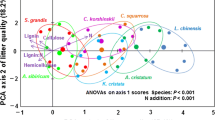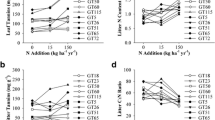Abstract
Anthropogenic forces are concurrently reducing biodiversity and altering terrestrial nutrient cycles. As natural populations decline, genetic diversity within single species also declines. The consequences of intraspecific genetic loss for ecosystem functions are poorly understood, and interactions among intraspecific diversity, nitrogen deposition, and nutrient cycling are unknown. We present results from an experiment that simulated both a decline in biodiversity and an increase in nitrogen deposition. In soil microcosms, we tested effects of variation in intraspecific litter diversity and nitrogen deposition on soil respiration and nitrogen leaching. Increases in intraspecific litter diversity increased soil respiration overall, with the greatest increases in respiration occurring under high nitrogen deposition. Nitrogen deposition increased the amount of inorganic nitrogen leached, while the amount of dissolved organic nitrogen leached was correlated with initial litter chemistry (lignin concentration) and remained independent of litter diversity and nitrogen deposition treatments. Our results demonstrate the potential for losses in genetic diversity to interact with other global environmental changes to influence terrestrial nutrient cycles.




Similar content being viewed by others
References
Aber J, McDowell W, Nadehoffer K, Magill A, Berntson G, Kamakea M, McNulty S, Currie W, Rustad L, Fernandez I (1998) Nitrogen saturation in temperate forest ecosystems. BioScience 48:921–934
Bengtsson J (1998) Which species? What kind of diversity? Which ecosystem function? Some problems in studies of relations between biodiversity and ecosystem function. Appl Soil Ecol 10:191–199
Berg E, Hamrick J (1995) Fine-scale genetic structure of a turkey oak forest. Evolution 49:110–120
Cabrera M, Beare M (1993) Alkaline persulfate oxidation for determining total nitrogen in microbial biomass extracts. Soil Sci Soc Am J 57:1007–1012
Chapin F III, Zavelta E, Eviner V, Naylor R, Vitousek P, Reynolds H, Hooper D, Lavorel S, Sala O, Hobbie S, Mack M, Diaz S (2000) Consequences of changing biodiversity. Nature 405:234–242
Driebe EM, Whitham TG (2000) Cottonwood hybridization affects tannin and nitrogen content of leaf litter and alters decomposition. Oecologia 123:99–107
Ekschmitt K, Klein A, Pieper B, Wolters V (2001) Biodiversity and functioning of ecological communities—why is diversity important in some cases and unimportant in others? J Plant Nutr Soil Sci 164:239–246
Fenn ME, Poth MA, Aber JD, Baron JS, Bormann BT, Johnson DW, Lemly AD, McNulty SG, Ryan DF, Stottlemyer R (1998) Nitrogen excess in North American ecosystems: predisposing factors, ecosystem responses, and management strategies. Ecol Appl 8:706–733
Fog K (1988) The effect of added nitrogen on the rate of decomposition of organic matter. Biol Rev 63:433–462
Hammell KE (1997) Fungal degradation of lignin. In: Cadisch G, Giller KE (eds) Driven by nature. CAB International, Wallingford, UK
Harborne J (1997) Role of phenolics secondary metabolites in plants and their degradation in nature. In: Cadisch G, Giller K (eds) Driven by nature: plant litter quality and decomposition. CAB International, Wallingford, pp 67–74
Hobbie SH, Vitousek PM (2000) Nutrient limitation of decomposition in Hawaiian forests. Ecology 81:1867–1877
Hunt HW, Ingham ER, Coleman DC, Elliott ET, Reid CPP (1988) Nitrogen limitation of production and decomposition in prairie, mountain meadow, and pine forest. Ecology 69:1009–1016
Hunter MD, Shultz JC (1995) Fertilization mitigates chemical induction and herbivore responses within damaged oak trees. Ecology 74:1226–1232
Huston MA (1997) Hidden treatments in ecological experiments: re-evaluating the ecosystem function of biodiversity. Oecologia 110:449–460
Ledig FT (1992) Human impacts on genetic diversity in forest ecosystems. Oikos 63:87–108
Loreau M, Hector A (2001) Partitioning selection and complementarity in biodiversity experiments. Nature 412:72–76
Loreau M, Naeem S, Inchausti P, Bengtsson J, Grime JP, Hector A, Hooper DU, Huston MA, Raffaelli D, Schmid B, Tilman D, Wardle DA (2001) Biodiversity and ecosystem functioning: current knowledge and future challenges. Science 294:804–808
Madritch MD, Hunter MD (2002) Phenotypic diversity influences ecosystem functioning in an oak sandhills community. Ecology 83:2084–2090
Magill A, Aber J (2000) Dissolved organic carbon and nitrogen relationships in forest litter as affected by nitrogen deposition. Soil Biol Biochem 32:603–613
Maly S, Korthals GW, Van Dijk C, Van der Putten WH, De Boer W (2000) Effect of vegetation manipulation of abandoned arable land on soil microbial properties. Biol Fertil Soils 31:121–127
McCann K (2000) The diversity-stability debate. Nature 405:228–233
McTiernan KB, Ineson P, Coward PA (1997) Respiration and nutrient release from tree leaf litter mixtures. Oikos 78:527–538
Norby RJ (1998) Nitrogen deposition: a component of global change analysis. New Phytol 139:189–200
Northup RR, Yu Z, Dahlgren RA, Vogt KA (1995) Polyphenol control of nitrogen release from pine litter. Nature 377:227–229
Perakis SS, Hedin LO (2002) Nitrogen loss from unpolluted South American forests mainly via dissolved organic compounds. Nature 415:416–419
Prescott CE (1995) Does nitrogen availability control rates of litter decomposition in forests? Plant Soil 168–169:83–88
Purvis A, Hector A (2000) Getting the measure of biodiversity. Nature 405:212–219
Qualls RG, Haines BL, Swank WT, Tyler SW (2000) Soluble organic and inorganic nutrient fluxes in clearcut and mature deciduous forests. Soil Sci Soc Am J 64:1068–1077
Reich PB, Knops J, Tilman D, Craine J, Ellsworth D, Tjoelker M, Lee T, Wedin D, Naeem S, Bahauddin D, Hendrey G, Jose S, Wrage K, Goth J, Bengston W (2001) Plant diversity enhances ecosystem responses to elevated CO2 and nitrogen deposition. Nature 410:809–812
Rossiter M, Schultz JC, Baldwin IT (1998) Relationships among defoliation, red oak, phenolics, and gypsy moth growth and reproduction. Ecology 69:267–277
SAS (1998) Version 8.2 for Windows TS2M0. SAS Institute, Cary, N.C.
Schimel J (1995) In: Chapin F III, Korner C (eds) Arctic and Alpine biodiversity: patterns, causes and ecosystem consequences. Springer, Berlin Heidelberg New York, pp 239–254
Sokal RR, Rohlf FF (2001) Biometry. Freeman, New York
Tilman D (1997) Distinguishing between the effects of species diversity and species composition. Oikos 80:185
Tilman D, Lehman CL, Thomson KT (1997) Plant diversity and ecosystem productivity: theoretical considerations. Proc Natl Acad Sci USA 94:1857–1861
Treseder K, Vitousek P (2001) Potential ecosystem-level effects of genetic variation among populations of Metrosideros polymorpha from a soil fertility gradient in Hawaii. Oecologia 126:266–275
Vitousek P (1994) Beyond global warming: Ecology and global change. Ecology 75:1861–1876
Vitousek PM, Aber JD, Howarth RW, Likens GE, Matson PA, Schindler DW, Schlesinger WH, Tilman DG (1997) Human alteration of the global nitrogen cycle: sources and consequences. Ecol Appl 7:737–750
Acknowledgements
This work was supported by grants from the Andrew W. Mellon Foundation and the National Science Foundation (Grants DEB-9906366 to M.D.H. and DEB-0104804 to M.D.M.). We also thank the Savannah River Site for site use permission and M. Cabrera, D. Coleman, J. Hamrick, P. Hendrix, R. Pulliam, R. Sharitz, B. Nuse, and J. Rogers for comments and/or laboratory assistance. Two anonymous reviewers greatly improved a previous version of this manuscript.
Author information
Authors and Affiliations
Corresponding author
Rights and permissions
About this article
Cite this article
Madritch, M.D., Hunter, M.D. Intraspecific litter diversity and nitrogen deposition affect nutrient dynamics and soil respiration. Oecologia 136, 124–128 (2003). https://doi.org/10.1007/s00442-003-1253-0
Received:
Accepted:
Published:
Issue Date:
DOI: https://doi.org/10.1007/s00442-003-1253-0




